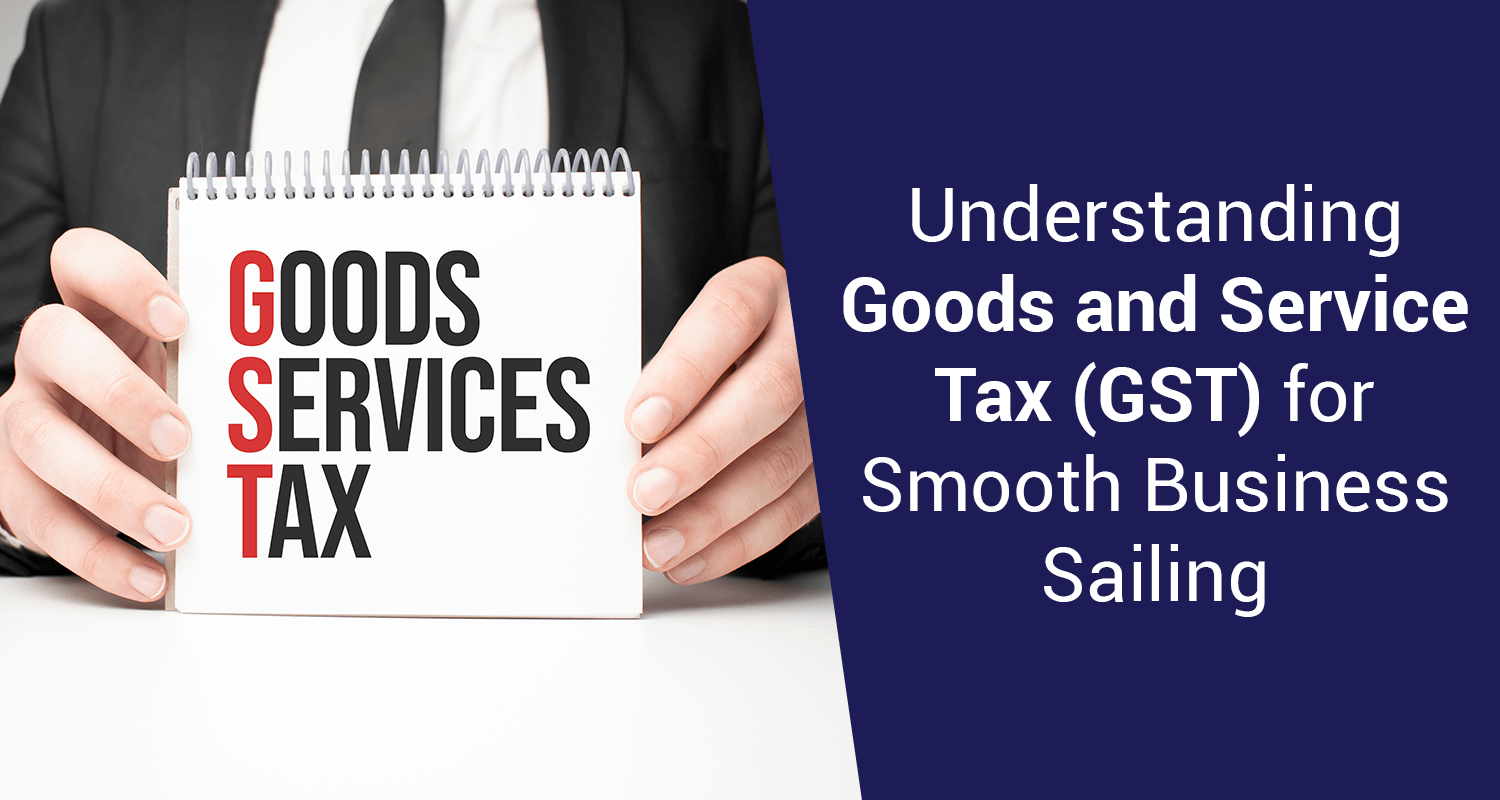GST - Goods and Service Tax

What is GST?
GST, or Goods and Service Tax, is a comprehensive indirect tax system replacing several individual taxes like VAT, excise duty, and service tax. It applies to the sale of goods and services, making taxation simpler and more transparent for businesses and consumers.Objectives and advantages of GST
- Lower costs: GST eliminates surging taxes, making goods and services cheaper for everyone.
- Simpler compliance: One unified tax replaces many, streamlining paperwork and processes.
- Improved efficiency: Removing logistical bottlenecks and speeding up tax credit claims boosts productivity.
- Wider tax base and increased revenue: This helps the government invest in critical areas, potentially benefiting the economy further.
- Reduced corruption: A transparent system minimizes tax evasion and false claims, promoting fair competition.
- Easier for small businesses: Simplified online platforms and processes encourage compliance in the unorganized sector.
GST Identification Number (GSTIN) – Your Tax Passport
Think of your GSTIN as your business's unique tax passport. It's a 15-digit alphanumeric code that identifies you as a registered GST taxpayer. You'll need this number to file returns, make payments, and even claim input tax credits.
Demystifying GST Returns: Your Tax Time Essentials
Filing GST returns can feel like deciphering a foreign language, but don't worry, we'll unpack it together! Different forms cater to specific needs, ensuring your tax reporting is accurate and efficient. Here's a breakdown of the main types of GST returns in India:
1. GSTR-1: Your Monthly Sales Journal
Think of GSTR-1 as your record of outgoing transactions for the month. This form details all the goods and services you've sold, categorized by tax rate (5%, 12%, 18%, or 28%). It's like your monthly sales journal, but for the taxman.2. GSTR-2: Currently on Hold (But Keep It on Your Radar!)
GSTR-2 used to be your "purchases diary," reporting all the goods and services you bought from other businesses. However, it's currently not mandatory for most taxpayers. But keep an eye out, as it might be reintroduced in the future.3. GSTR-3B: Your Monthly Tax Summary
This is your monthly one-stop shop for GST! GSTR-3B summarizes your sales (from GSTR-1), purchases (if applicable), tax liability, and input tax credit (tax you pay on purchases that you can claim back). It's like a bird's-eye view of your tax situation for the month.4. GSTR-9: Your Annual Report Card
Think of GSTR-9 as your yearly tax evaluation. It's a more detailed version of GSTR-3B, covering the entire financial year. It provides a comprehensive picture of your business's financial health and tax compliance.5. GSTR-9C: The Reconciliation Champion (For High Flyers)
If your turnover in a year exceeds Rs. 2 crores, you'll need to file GSTR-9C along with GSTR-9. This form bridges your annual return and your audited financial statements, ensuring everything matches up perfectly.Navigating the GST Maze: Understanding the Four Tax Types
Understanding the different types of GST can feel like navigating a labyrinth, but it doesn't have to be overwhelming! Here's a simplified breakdown of the four key types:1. Intra-State Transactions:
State Goods and Services Tax (SGST): Implemented by the state government on the sale of goods and services within the same state. Revenue goes directly to the state.
Central Goods and Services Tax (CGST): Also levied on intra-state transactions, but by the central government. This creates a unified tax structure and shared revenue between the center and state.
2. Inter-State Transactions:
Integrated Goods and Services Tax (IGST): This applies to goods and services crossing state borders and imports and exports. Revenue is shared between the center and state based on a pre-determined formula.3. Union Territories:
Union Territory Goods and Services Tax (UGST): Similar to SGST, but levied by and collected within Union Territories.Sapna aapka. Business Loan Humara.
Apply NowCrunching the GST Numbers: Making Tax Calculations Simple
When you calculate GST it might seem intimidating, but it's actually quite straightforward. Let's break it down into simple steps, with a handy example to make it crystal clear:1. Identify the Taxable Value:
- This is the base price of the goods or services you're selling, excluding any taxes.
- Example: You're selling a laptop for Rs. 50,000. That's your taxable value.
2. Determine the Applicable GST Rate:
- Different goods and services fall under different GST slabs. Common rates are 5%, 12%, 18%, and 28%.
- Check the GST rate applicable to your product category.
- Example: Laptops attract a GST rate of 18%.
3. Apply the Formula:
- Once you have the taxable value and GST rate, it's time for a quick calculation.
- Formula: Taxable value x GST rate = GST amount
- Example: 50,000 x 18/100 = Rs. 9,000
4. Add GST to the Price:
- The GST amount you just calculated needs to be added to the original price to determine the customer's final price.
- Example: 50,000 + 9,000 = Rs. 59,000 (final price with GST)
Key Points to Remember:
- Inclusive vs. Exclusive Pricing:
- Inclusive pricing already includes GST within the displayed price.
- Exclusive pricing shows the price without GST, which is added at the time of payment.
- Input Tax Credit (ITC):
- If you've paid GST on purchases for your business, you can claim ITC to offset your GST liability. Check out how the GST Council oversees ITC claims.
GST Registration: Quick and Simple
- Who needs to register: Businesses paying service tax, VAT, or central excise must register for GST.
- Where to register: Start the process on the GST portal (www.gst.gov.in)
- What happens after applying: You'll receive an ARN (Application Reference Number) to track progress.
- How long it takes: Registration certificate and GSTIN (15-digit tax code) typically arrive within a week.
- Who needs a GSTIN: Businesses with annual turnover above Rs. 20 lakh must have a GSTIN.
Documents required for GST Registration: Get Your Papers Ready
To register for GST, you'll need to gather some essential documents:
- PAN card
- Business registration certificate (if applicable)
- Address proof
- Bank account details
- Ownership or possession papers of business premises
Steps to File GST Return Online: Tax in a Click
Filing GST returns has become a breeze, thanks to the online portal. Here's a quick guide:
1. Visit the GST portal (www.gst.gov.in)
2. Log in using your GSTIN and password
3. Select the appropriate return type
4. Fill in the required details
5. Upload any supporting documents
6. Verify and submit the return
GST Tax Slabs: A Quick Peek
Four main slabs: 5%, 12%, 18%, and 28%.
Essentials like food and medicines go lower, while luxury items fall in higher brackets.
Goods examples:
5%: apparel (below Rs. 1,000), medicines, tea, basic groceries
12%: mobile phones, ayurvedic medicines, ghee
18%: biscuits, hair oil, AC restaurants
28%: chocolates, automobiles, washing machines
Services examples:
5%: economy class airfare, restaurants with turnover below Rs. 50 lakh
12%: hotels (Rs. 1,000-2,500 per night), business class airfare
18%: AC hotels, telecom services, IT services
28%: 5-star hotels, gambling, cinema
Note: GST on Gold has a separate 3% slab, and some special supplies are zero-rated (no GST).
New GST Compliance Measures: A Snapshot
E-way bills: A digital system tracking goods movement, reducing check-post delays and tax evasion.
E-invoicing: Mandatory for businesses exceeding Rs. 100 crore turnover, boosting accuracy and interoperability.
HSN code requirements: Businesses must mention specific codes for goods and services on invoices to streamline categorization and tax assessment.
GST Compliance: Your Secret Weapon for Business Loans
Need a business loan to expand your operations? Your GST compliance can play a crucial role in securing one. Lenders often consider a strong GST track record as a sign of financial discipline and credibility. This makes it easier for you to secure a loan in the future.
GST is a journey towards a unified tax system, streamlining business operations and enhancing transparency. By understanding its key concepts, registration process, return filing mechanisms, and impact on business loans, you can confidently navigate this tax landscape and ensure smooth sailing for your business.
Sapna aapka. Business Loan Humara.
Apply NowDisclaimer : The information in this blog is for general purposes only and may change without notice. It does not constitute legal, tax, or financial advice. Readers should seek professional guidance and make decisions at their own discretion. IIFL Finance is not liable for any reliance on this content. Read more



